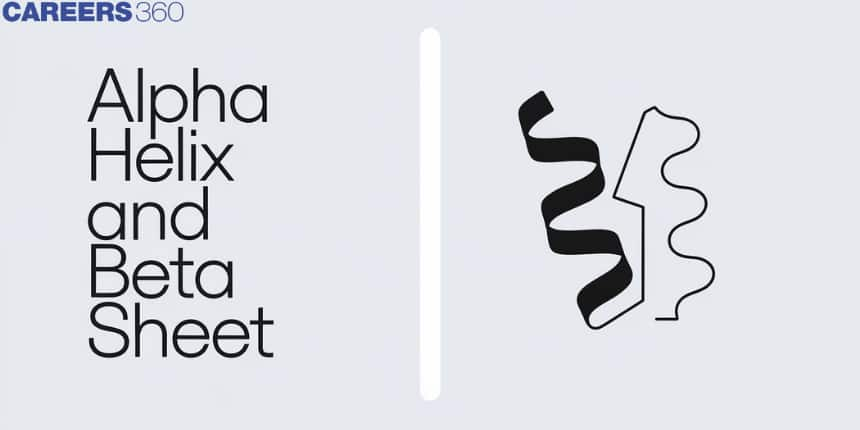Alpha Helix And Beta Sheet: Introduction, Structure, Types, Difference, FAQs
Secondary protein structures include alpha helix and beta sheet. Both are formed by hydrogen bonding between the carbonyl-O of one amino acid and the amino-H of another. This section describes proteins, types of proteins, and protein primary and secondary structures. i.e., alpha helices and beta sheets.
This Story also Contains
- Proteins
- Types Of Proteins
- Alpha Helix Proteins
- Beta Sheet Proteins
- Difference Between Alpha Helix And Beta Sheet

Proteins
Proteins are large, complex molecules that play an important role in our bodies. It is responsible for most of the functions of cells and is necessary for the structure, function, and regulation of the tissues and organs of the body.
Proteins are composed of hundreds or thousands of long chains of small amino acids. The sequence of amino acids determines the structure and function of proteins. Twenty kinds of amino acids combine to make proteins.
Types Of Proteins
Based on structures, proteins can be divided into two types-
Primary protein
Secondary protein
1. Primary protein
Each protein has a characteristic primary structure that differs in the arrangement of amino acids and the total number of amino acids present in the protein molecule. Haemoglobin is an example of a primary protein.
2. Secondary Proteins
Secondary proteins are three-dimensional forms of local protein segments. It is mainly defined by hydrogen bonding between amino acid and carboxyl oxygen atoms. Types of protein secondary structures are alpha helices and beta sheets.
Alpha Helix Proteins
The most common secondary structure of proteins is the alpha helix. Linus Pauling predicted the structure of alpha-helical proteins. This prediction was confirmed when the first three-dimensional structure of the protein myoglobin was determined by X-ray crystallography. In alpha-helical proteins, hydrogen bonds form between the N-H and C-O groups of amino acids. The alkyl groups of the alpha-helical chain do not participate in hydrogen bonding but retain the alpha-helical structure. Each turn of the helix has 3.6 amino acid residues.
Beta Sheet Proteins
The second major type of protein secondary structure is the beta-sheet protein sheet. It consists of various beta strands connected by hydrogen bonds between adjacent strands. Three to ten amino acids join together to make a β-strand polypeptide. β-sheets are involved in the formation of fibrils and protein aggregates seen in amyloidosis. Similar to the alpha helix, the residual hydrogen bonds between adjacent strands are separated.
Difference Between Alpha Helix And Beta Sheet
Alpha Helix- The alpha-helical amino acids exist in a right-handed coiled rod-like structure. Within the polypeptide chain, intramolecular hydrogen bonds form to form a helical structure. 3.6 amino acid residues are coiling to form an alpha-helical polypeptide. An alpha helix can be a single polypeptide chain. The -helix alkyl groups point away from the helix. Keratin, myoglobin, and haemoglobin are a few examples.
Beta Sheet- The beta-sheet amino acid is in an almost fully extended conformation. It has a linear or sheet-like structure. Beta-sheets are formed by joining two or more beta-strands via intermolecular hydrogen bonding in beta-strand polypeptides. Beta sheets are not included in single-chain polypeptides. There must be two beta strands. Alkyl groups are located both inside and outside the sheet. for example, dermal fibres or fibroin.
Frequently Asked Questions (FAQs)
Proteins are large, complex molecules that play an important role in our bodies. It is responsible for most of the functions of cells and is necessary for the structure, function, and regulation of the tissues and organs of the body.
Proteins are composed of hundreds or thousands of long chains of small amino acids. The sequence of amino acids determines the structure and function of proteins. Twenty kinds of amino acids combine to make proteins.
The types of proteins are:
1. Primary protein
Each protein has a characteristic primary structure that differs in the arrangement of amino acids and the total number of amino acids present in the protein molecule. Haemoglobin is an example of a primary protein.
2. Secondary Proteins
Secondary proteins are three-dimensional forms of local protein segments. It is mainly defined by hydrogen bonding between amino acids and carboxyl oxygen atoms. Protein secondary structures include alpha helices and beta sheets.
The most common secondary structure of proteins is the alpha helix.
Linus Pauling predicted the structure of alpha-helical proteins. This prediction was confirmed when the first three-dimensional structure of the protein myoglobin was determined by X-ray crystallography. In alpha-helical proteins, hydrogen bonds form between the N-H and C-O groups of amino acids. The alkyl groups of the alpha-helical chain do not participate in hydrogen bonding but retain the alpha-helical structure. Each turn of the helix has 3.6 amino acid residues.
The second major type of protein secondary structure is the beta-sheet protein structure. It consists of various beta strands connected by hydrogen bonds between adjacent strands. A single-stranded polypeptide is made up of three to ten amino acids. - Sheets are involved in the formation of fibrils and protein aggregates seen in amyloidosis. Similar to the alpha helix, the residual hydrogen bonds between adjacent strands are separated.
The difference between an alpha helix and a beta sheet is:
Alpha Helix: The alpha helical amino acids exist in a right-handed coiled rod-like structure. Within the polypeptide chain, intramolecular hydrogen bonds form to form a helical structure. 3.6 amino acid residues are coiling to form an alpha-helical polypeptide. An alpha helix can be a single polypeptide chain. The -helix alkyl groups point away from the helix. Keratin, myoglobin, and haemoglobin are a few examples.
Beta Sheet: The beta-sheet amino acid is in an almost fully extended conformation. It has a linear or sheet-like structure. Beta-sheets are formed by joining two or more beta-strands via intermolecular hydrogen bonding in beta-strand polypeptides. Beta sheets are not included in single-chain polypeptides. There must be two beta strands. Alkyl groups are located both inside and outside the sheet. for example, dermal fibres or fibroin.